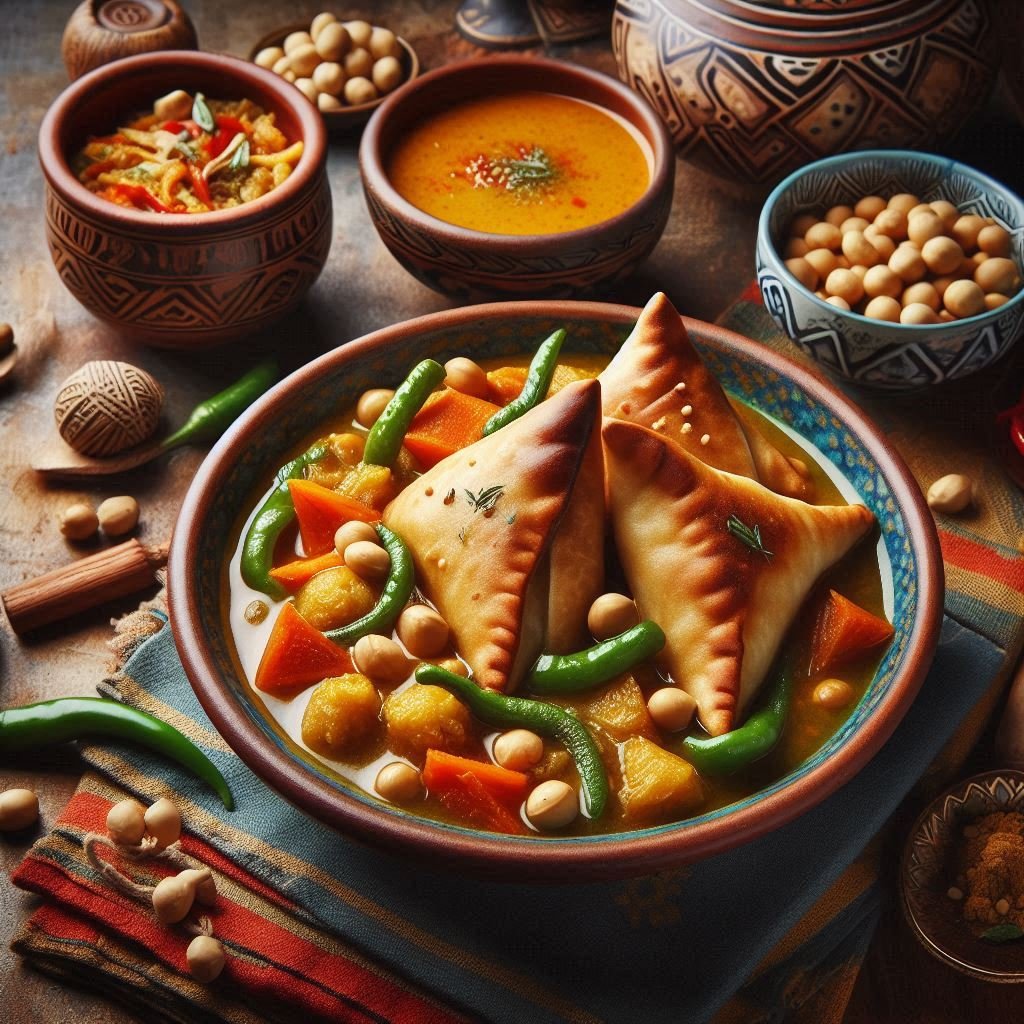Introduction to the Fusion of Asiatic and African Cuisines
The fusion of Asiatic and African cuisines represents a remarkable confluence of tastes, techniques, and traditions from two of the most vibrant cultural landscapes. The culinary traditions of Asia and Africa have long been shaped by historical exchanges in trade, migration, and cultural interactions. This melding of cuisines has given rise to an array of unique dishes that epitomize the richness and diversity of both regions.
Historically, the spice routes facilitated the exchange of ingredients, ideas, and culinary practices between Asia and Africa. Spices like turmeric, ginger, and cinnamon, staples in Asian cooking, found their way into African kitchens, enriching local recipes and creating new flavor profiles. Similarly, Africa’s rich agricultural produce, such as cassava, plantains, and legumes, has become incorporated into various Asian dishes, enhancing their nutritional and taste value.
The shared ingredients extend beyond spices and produce to proteins and legumes. Lentils, chickpeas, and fish are common in both cuisines, forming the backbone of many beloved dishes. Techniques such as steaming, grilling, and stewing are prevalent on both continents, allowing the creation of meals that are both flavorful and healthful. From Moroccan tagines to Indian curries, the interplay of flavors and techniques showcases a culinary dialogue that transcends borders.
The result of this fusion is an exciting array of dishes that leverages the best Asiatic-African flavors. These foods do not merely satiate hunger but also tell stories of cultural exchange and adaptation. They highlight the ingenuity of chefs and home cooks who meld diverse elements into harmonious creations. Furthermore, the fusion fosters a broader understanding and appreciation of the rich cultural tapestry of Asia and Africa, bridging geographical and culinary divides.
In this exploration of African-Asian gastronomic innovation, one can truly appreciate the seamless blend of traditions that produces dishes marked by complexity, depth, and a shared heritage. The fusion cuisine not only captivates the palate but also reflects a deeper narrative of cultural interconnectedness and mutual influence.
Key Ingredients and Spices in Asiatic-African Cuisine
The fusion of African and Asian culinary traditions culminates in a rich tapestry of flavors and textures. The foundation of any great Asiatic-African dish lies in its ingredients and spices, which are carefully selected to create a harmonious balance. Staples like rice, maize, and yams serve as the base for many dishes, providing the essential carbohydrates that underpin these meals. Complementing these are ingredients like coconut milk and peanuts, which introduce a creamy and nutty element, enhancing the overall flavor profile.
Root vegetables such as ginger and garlic are indispensable in both African and Asian foods. Ginger imparts a pungent, slightly sweet warmth that pairs well with the earthy flavors found in many traditional dishes, while garlic adds depth and a robust savoriness. Various peppers, including chili peppers, are often used to add heat and complexity, reflecting the bold characteristics of Asian cuisine and the hearty spice elements common in African cooking.
Spices play a crucial role in crafting the signature flavors of Asiatic-African cuisine. Turmeric, with its vibrant color and subtle bitterness, is frequently used to add a warm, golden hue to dishes. Cumin, appreciated for its earthy and aromatic qualities, enhances the richness of both meat and vegetable preparations. Coriander, both in seed and leaf form, contributes a citrusy brightness that can lighten dense flavors. Cardamom, a staple in many Asian dishes, offers a unique, sweet-spicy dimension that elevates the palate.
One spice blend that exemplifies the fusion of these culinary traditions is berbere. This Ethiopian spice mix combines elements like chili peppers, garlic, ginger, basil, and fenugreek, resulting in a complex, aromatic blend that brings depth and warmth to various dishes. The combination of such spices and ingredients not only creates vibrant and aromatic meals but also showcases the profound culinary connection between Africa and Asia. The harmonious blending of these elements is what makes exploring the best Asiatic-African dish an enriching and palate-pleasing journey.
Signature Asiatic-African Dishes
Asiatic-African cuisine represents a remarkable fusion of culinary traditions. This intersection of cultures brings forth unique dishes that marry diverse flavors and techniques, providing a rich dining experience. To exemplify the best of this fusion, we delve into a selection of signature dishes that highlight the vibrant multicultural tapestry of these regions.
East African Samosas: Known for their crispy exterior and flavorful filling, East African samosas are a popular street food that showcases the harmonious blending of African and South Asian culinary influences. Typically filled with minced meat, lentils, or vegetables, they are spiced with a mix of coriander, cumin, and chili, and then deep-fried to perfection. The incorporation of spices from the Indian subcontinent provides a distinctive taste that sets them apart from their counterparts elsewhere.
North African Tagine with an Asian Twist: A traditional North African tagine, named after the earthenware pot it’s cooked in, is a slow-cooked stew that often features meat or fish combined with vegetables, dried fruits, and a medley of spices like saffron, cinnamon, and ginger. Introducing an Asian twist to this dish, such as adding soy sauce, lemongrass, or miso, enhances the complexity of flavors. The resulting dish presents an exquisite balance of savory and sweet, reflective of both African and Asian gastronomic influences.
West African Peanut Soup with Southeast Asian Flavors: This dish reimagines the hearty and comforting West African peanut soup by integrating Southeast Asian elements. The base remains a rich, creamy peanut broth, often prepared with chicken or beef, and infused with local spices like chili and garlic. By adding coconut milk, fish sauce, and kaffir lime leaves, the dish gains a refreshing tropical dimension. This marriage of flavors not only enriches the traditional soup but also exemplifies the innovative spirit of African-Asian foods.
These dishes represent just a glimpse into the culinary wonders of Asiatic-African cuisine. Each recipe is a testament to the creative melding of African and Asian flavors, illustrating the cultural significance and gastronomic ingenuity that characterize this vibrant fusion.
Bringing Asiatic-African Cuisine to Your Kitchen
Exploring the best Asiatic-African dish begins with understanding the delicate balance of flavors that define this unique culinary fusion. To recreate these exotic and flavorful dishes at home, start by sourcing authentic ingredients. Visit local specialty shops or explore online suppliers to procure essential spices and herbs, such as berbere, cloves, star anise, and tamarind. Combining these ingredients in the right proportions is crucial for achieving the distinctive African-Asian flavors.
Investing in essential kitchen tools will greatly enhance your cooking experience. A good quality mortar and pestle is invaluable for grinding spices, while a wok can be indispensable for stir-frying. Additionally, having a fine mesh sieve and a rice cooker can simplify many recipes. Learning to use these tools effectively can significantly impact the authenticity of your Asiatic-African culinary efforts.
Embarking on creating African-Asian dishes requires mastering a few fundamental techniques. Techniques such as marinating meat in spices, mastering the art of stirring fry with high heat, and balancing sweet, sour, and spicy notes are critical. Practice these methods to achieve the most flavorful results. For instance, marinating chicken with a mixture of ginger, garlic, turmeric, and chili paste for at least an hour before cooking can infuse the meat with deep flavors.
To get you started, here’s a simple yet delicious recipe: Spicy Coconut Chicken Stir-Fry. Begin by slicing 500 grams of chicken breast into thin strips. Marinate the chicken in a mix of 1 tablespoon of minced ginger, 2 cloves of minced garlic, and 1 teaspoon of turmeric powder for 30 minutes. Heat 2 tablespoons of vegetable oil in a wok, and stir-fry the chicken for about 5 minutes until fully cooked. Add sliced red peppers, chopped green beans, and a can of coconut milk. Season with salt, pepper, and a pinch of ground cloves. Simmer until the vegetables are tender and serve hot with steamed jasmine rice.
Experimenting with Asiatic-African recipes allows for a delightful exploration of diverse culinary traditions. While it is essential to preserve the authenticity of these traditional dishes, do not shy away from adding your unique twist. Combining ingredients and techniques across these rich culinary landscapes can lead to innovative and mouth-watering creations. Enjoy the journey of bringing African-Asian flavors to your kitchen!













